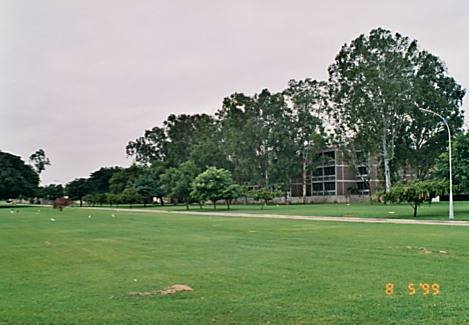 ICRISATiInternational Crops Research Institute for the Semi-Arid Tropics) is located in the suburban area of Hyderabad City, Andhra Pradesh. Hyderabad is now known as one of India's high tech centers. After one hour drive from Indian chaos in Hyderabad, I reached Patancheru Village where the ICRISAT sits. Inside the campus of the ICRISAT was another world: no chaos but calmness; no congestion but natural beauty; no dust but all green. Many waterbirds come to the campus, which is surrounded by fields of pulses and millets.
ICRISATiInternational Crops Research Institute for the Semi-Arid Tropics) is located in the suburban area of Hyderabad City, Andhra Pradesh. Hyderabad is now known as one of India's high tech centers. After one hour drive from Indian chaos in Hyderabad, I reached Patancheru Village where the ICRISAT sits. Inside the campus of the ICRISAT was another world: no chaos but calmness; no congestion but natural beauty; no dust but all green. Many waterbirds come to the campus, which is surrounded by fields of pulses and millets.On this campus, a Telug movie "Preminchukundam Ra!" was shot. The movie became the first Telugu film introduced to Japan. When I was watching it, I suddenly found the heroine dancing in front of the dormitory I was staying. The photo on the left shows the place.

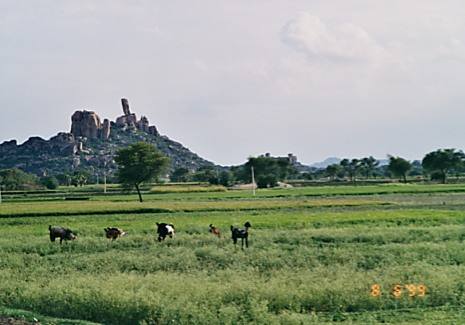 After I presented a preliminary version of my paper at the ICRISAT Seminar, I and Mr. R., who participated in the 1975-84 survey, left for the villages. The first village was Aurepalle, Mahbubnagar District, Andhra Pradesh. When the survey began in the early 1970s, all the roads were unpaved. Now it is paved but very rugged. The village is surrounded by strange rocks, shown in the photo on the right.
After I presented a preliminary version of my paper at the ICRISAT Seminar, I and Mr. R., who participated in the 1975-84 survey, left for the villages. The first village was Aurepalle, Mahbubnagar District, Andhra Pradesh. When the survey began in the early 1970s, all the roads were unpaved. Now it is paved but very rugged. The village is surrounded by strange rocks, shown in the photo on the right.
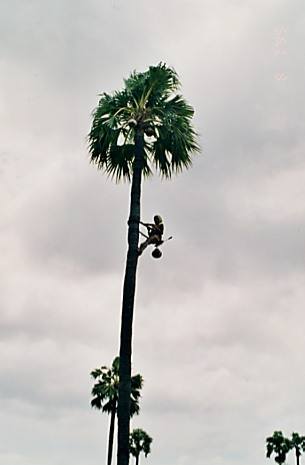 We stayed with a landlord's house in the village. We interviewed a number of farmers, artisans, moneylenders, and so on. Among them, Gouda people were very impressive. Their traditional job is to make "Todee" (palm beer). Todee making is an important source of villagers' income. Everyday, Gouda men climb up high palm trees, probably 20m high (Photo, left). Their only safety net is a cloth around their waist. They go up to the top in a second, set an earthen pot, and climb down to the ground. Next day when they pick up the pot from the tree top, "Todee" is ready for drinking.
We stayed with a landlord's house in the village. We interviewed a number of farmers, artisans, moneylenders, and so on. Among them, Gouda people were very impressive. Their traditional job is to make "Todee" (palm beer). Todee making is an important source of villagers' income. Everyday, Gouda men climb up high palm trees, probably 20m high (Photo, left). Their only safety net is a cloth around their waist. They go up to the top in a second, set an earthen pot, and climb down to the ground. Next day when they pick up the pot from the tree top, "Todee" is ready for drinking.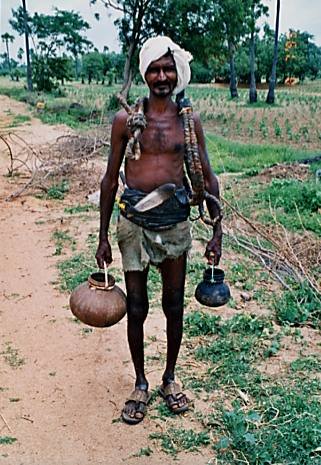 The photo on the right shows a Gouda man who just went down from a palm tree. Of course I asked for a taste--"Todee" was so mild and sour, just like Japanese "Doburoku." I really liked it and took a couple of drinks. Mr. R. said to me "Don't buy Todee in the town. It is mixed with sweets and other materials. It is best to buy Todee directly from Gouda men under palm tress."
The photo on the right shows a Gouda man who just went down from a palm tree. Of course I asked for a taste--"Todee" was so mild and sour, just like Japanese "Doburoku." I really liked it and took a couple of drinks. Mr. R. said to me "Don't buy Todee in the town. It is mixed with sweets and other materials. It is best to buy Todee directly from Gouda men under palm tress."This village changed a lot since the ICRISAT survey. Typical dry cropping, such as intercropping of pulses with Bajra (pearl millet) or Jowar (sorghum), was observed only occasionally. Farmers preferred to have a tubewell and to grow paddy using irrigation water from the tubewell. Land holding was once concentrated among Reddy caste people; now many Gouda people own land.
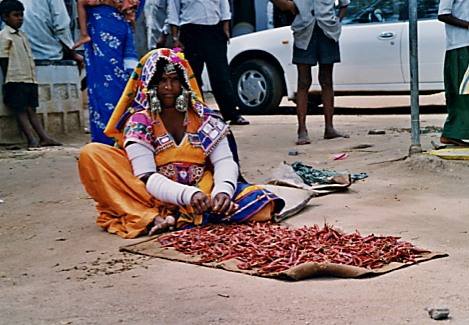 By the way, the photo on the right shows a tribal woman who came to a town near Aurepalle to sell chili. She belongs to Scheduled Tribes, for which affirmative actions is taken by the government. Their colorful dress was so beautiful with rural green background.
By the way, the photo on the right shows a tribal woman who came to a town near Aurepalle to sell chili. She belongs to Scheduled Tribes, for which affirmative actions is taken by the government. Their colorful dress was so beautiful with rural green background.
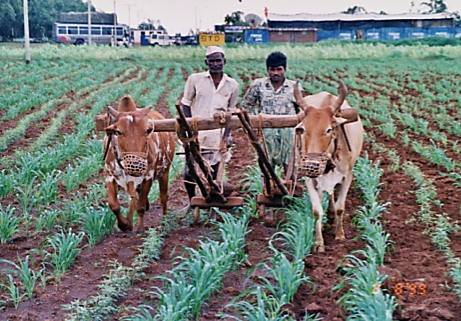 The next destination is Shirapur Village, Solapur District, Maharashtra. The drive from Aurepalle to Shirapur was indeed exciting from agronomic viewpoint. After every minute, soils and rainfall pattern change, resulting in a different cropping pattern. The photo on the left was taken in Karnataka State on the way. It was a typical intercropping--three or four rows of Bajra (pearl millet) and then one row of pigeonpea. As you can see from the photo, intercultivation is necessary. Tractors cannot do this job since tractor cultivation damages crops. Draft bullocks are very active in Deccan, India.
The next destination is Shirapur Village, Solapur District, Maharashtra. The drive from Aurepalle to Shirapur was indeed exciting from agronomic viewpoint. After every minute, soils and rainfall pattern change, resulting in a different cropping pattern. The photo on the left was taken in Karnataka State on the way. It was a typical intercropping--three or four rows of Bajra (pearl millet) and then one row of pigeonpea. As you can see from the photo, intercultivation is necessary. Tractors cannot do this job since tractor cultivation damages crops. Draft bullocks are very active in Deccan, India.
Shirapur witnessed a huge change since the 1975-84 survey. Perennial canal now irrigates the village. With full irrigation facility, subsistence semi-arid farming disappeared almost completely. Farmers no longer grow pigeonpea or bajra. In the village, I saw sugarcane, cotton, fruits orchards, and vegetable gardens. The village is now more like a modern Indian village with intensive agriculture.
Nevertheless, the memory of old days with risky agriculture is still fresh in the farmers' heart. A farmer we interviewed showed us a picture taken 15 years ago when the ICRISAT research team was doing household surveys in the village. The same farmer with a very young face was found in the stained photo.
After Shirapur, we went to the third village: Kanzara, Akola District, Maharashtra. This village is endowed with a more stable rainfall than the other two villages. Also, its land soil has high water conserving capacity. Therefore, farmers cultivate cotton as their main cash crop under rainfed condition. What was striking to me was that cotton is also intercropped with other crops. Every field is different in terms of crop choices and row combination. I saw the most diversified cropping patterns with intercropping in this village. However, according to villagers, monocropping is gradually increasing in this village as well.
The day we visited Kanzara was a day of the total eclipse. Since Akola City was one of those Indian cities where the eclipse was completely total, many media people visited the city. Unfortunately, due to monsoon clouds, we could not observed the eclipse directly with our eyes. Nevertheless, the sudden darkness at the time of the total eclipse was so stark that every life stopped at that moment.
After Kanzara Village, we came back to the ICRISAT campus. It took us about 2000km driving to visit all three villages. Many, many thanks to Mr. R. and our driverI